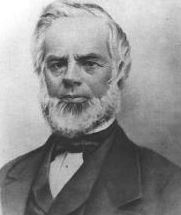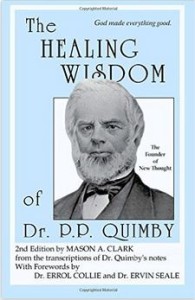Phineas Parkhurst Quimby was born on February 16, 1802. He was one of seven children brought up in a modest family background. When he was still a toddler, the family moved to Belfast, Maine, where he spent most of his life.
As a boy, he became interested in the sciences, but had no formal tuition in any of them. He became a skilled clockmaker and inventor with several patents to his name. One of his clocks, on a church tower in Belfast, is 170 years old and still keeps perfect time. He married in 1827 and had four children.
Julius Dresser, a patient who knew him well, described him as ‘a small man weighing less than 9 stone (57 Kg), well proportioned, with dark eyes, a piercing gaze and a somewhat nervous disposition. ‘
In his early thirties he became desperately ill with tuberculosis. He became so frail he had to give up his clock-making business. He later wrote, ‘Thirty years ago I was very sick, and was considered fast wasting away…. I was told that my liver was affected and my kidneys diseased, and that my lungs were nearly consumed. I believed all this, from the fact that I had all the symptoms, and could not resist the opinion of the physician…. Losing all hope, I gave up to die.’
Before long, Quimby became disillusioned with doctors. In those days, general medical practice killed as many people as it cured. If they couldn’t help him, he reasoned, he would have to help himself. A friend suggested he should take up horse-riding as the fresh air would do his ailing lungs some good. But he was too weak to mount a horse, so he borrowed a horse and cart and wiled away the hours exploring the dirt tracks of Southern Maine.
One day the horse stopped at the bottom of a hill and refused to pull the cart any further. He climbed down and walked the horse up the hill. When they reached the summit, he got back on the cart and drove the horse down the hill. When he arrived home, he realised he was breathing freely and the pain had gone. Although not cured, he felt so much better he was able to resume his business.
But Quimby wasn’t going to let matters rest there. If the doctor’s diagnosis was correct, he shouldn’t have been able to do what he had just done, so what brought this about? In trying to understanding what had occurred, he reasoned there must be something inside us that can make us well.
By the mid 1830s, he had heard of the work of Anton Mesmer, a Viennese doctor with a reputation for remarkable healings in Europe. He claimed that he could correct imbalances using magnets. The cure was supposed to be due to a mysterious fluid which entered the patient’s body via the magnet, thus healing the condition.
In 1838, Quimby attended a demonstration of ‘mesmerism’ given by a Dr Charles Poyenne. He was fascinated by what he saw and heard. Quimby was not the type to easily accept others’ opinions, so he looked into the subject and soon he was an expert hypnotist. He met a young man named Lucius Burkmar who was not only an excellent hypnotic subject, but also had extraordinary clairvoyant powers. Under hypnosis Lucius could apparently ‘examine’ a patient, describe their disease and suggest a remedy.
The two men conducted public demonstrations, which brought them to the attention of the church. Local religious leaders denounced his work as the work of the devil. In response Quimby accused the Church of undermining the Christian faith.
The medical fraternity were no kinder. Most condemned him as a charlatan, although some local doctors sought his help with patients who were not responding to treatment. He was often called upon to anesthetize patients for surgery, since the only anaesthetic available in those days was a large shot of alcohol.
On one occasion, he was called upon to hypnotise an army officer whose arm was to be amputated, having been crushed in an accident. The operation went well, but afterwards the officer reported that he still felt pain in the arm. Quimby wondered how this could be. The officer had not yet accepted that he had lost the arm, but when, with Quimby’s help, he did, the pain ceased.
As his experiments with Lucius progressed, Quimby found he could transfer his thoughts to Lucius. When he visualised something, the hypnotised Lucius did too. On one occasion, he got Lucius to hand him his hat by silent command. On another, he projected an image of a bear to Lucius, who recoiled in fear.
One day he asked Lucius in trance to diagnose his condition, since he was not yet one hundred percent cured. Lucius placed his hands on Quimby’s lower back and declared that a piece of one his kidneys was hanging by a thread. Lucius offered to make it grow back together. He replaced his hands on that area and the pain immediately ceased. Quimby never again experienced pain there. It made him think: surely the cure couldn’t have been anything Lucius had done? ‘The absurdity of the remedy made me doubt that the kidneys were diseased,’ he wrote. Had he been deceived into believing that he was ill? Were Lucius’s remedies really placebos?
He concluded that he was ill because he had believed the doctors’ explanation. He began to doubt whether Lucius had ever diagnosed a genuine illness. If he merely tuned in to the patient’s beliefs about their condition, he was nothing more than a mind reader. He was dealing with opinions rather than truth, and Quimby had no time for opinions. So, incredibly, he dispensed with Lucius and gave up hypnotism. It was, he later said, ‘the humbug of the age’.
Instead he set himself the challenge of finding a mentally-based healing method that anyone could use on themselves and others. His son George wrote: ‘To reduce his discovery to a science which could be taught for the benefit of suffering humanity was the all-absorbing idea of his life.’
After finishing with Lucius, Quimby’s own clairvoyant abilities started to develop. He became convinced that we all have powers of extra sensory perception, but only if we believe we have. He also realised that one mind could influence another not only in the hypnotic state, but also in the normal waking state. Furthermore, he became convinced that disease was inextricably linked to the beliefs of the person and that changes in the mind of the patient would affect their physical condition.
But how could he bring this about? Having abandoned hypnotism, the only power to influence his patients that he had at his disposal was the power of reason. So he reasoned with them, trying to get them to see the causes of their illnesses for themselves and get rid of their error thinking. He used no mystical words or rituals, just logic, clear explanations and true-to-life examples.
As time passed, he became fed up with trying to get through to his patients verbally, so he tried doing it nonverbally. He would sit with them in silence and get an impression of their condition. Then he conjured up a mental image of a courtroom and addressed the judge. ‘This person has been accused of having a disease by that doctor, and he’s innocent,’ he would say. Then he argued the case in his imagination. ‘If I get the verdict,’ he wrote, ‘the criminal is set at liberty.’ Sometimes barely a word was spoken – Quimby’s thoughts somehow impacted on the patient, and they were cured.
In 1859, after years of helping people with a wide range of health problems, he set up an office in Portland, about 80 miles from Belfast. He practised there for the last seven years of his life. Among the conditions he cured was cancer, back pain, tuberculosis, neuralgia, tumours, diphtheria and lameness. If no cure was affected, no fee was charged. Often he was the last resort. ‘People call for me and the undertaker at the same time,’ he wrote. ‘Whoever gets there first gets the case.’
Quimby sought no publicity. Julius Dresser wrote. ‘He was one of the most unassuming of men that ever lived….. To this was united a benevolent and unselfish nature and a love of truth, with a remarkable keen perception.’
The medical and religious fraternities accused him of being successful only among the credulous, simply because they were desperate or couldn’t get any worse. Consequently he reserved his greatest scorn for priests and doctors. He blamed them for most of the pain and sickness in the world because they planted fear-thoughts in the minds of their constituents. Echoing Yeshua, he pointed out that only the sick needed a doctor; the well could not possibly understand.
In his later years, he enjoyed loyal and affectionate support among the sick and the suffering, but they were a small minority compared with those ranged against him. In the end, it was his very success that killed him. He died at home in Belfast on January 16th 1866 of over-work and self-neglect, a few weeks short of his sixty-fourth birthday. In his last seven years, he had seen over ten thousand patients.
Quimby had known nothing of quantum physics, radionics or germ theory, and yet, uncannily, had tapped into it all. He knew that he had discovered the secret of healing and – more than this – our understanding of what it means to be a human being – as we shal see. It took more than a century before science began to catch up, but to the medical fraternity and most of the public he and his methods were, and still are, humbug.
©David Lawrence Preston, 29.3.2017
Follow me on Facebook and Twitter @feelinggoodatt



